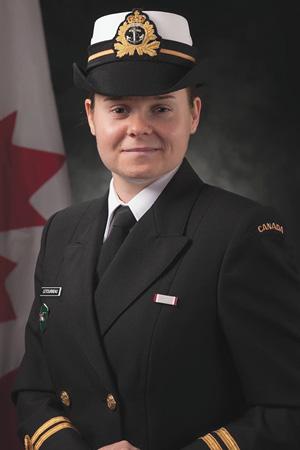
Joined
Joined the Royal Canadian Navy in 2006
Postings
- CFB Halifax
Joining the military
Emilie Létourneau grew up in Rouyn-Noranda, Quebec—population 40,000. Her origins may have been humble, but her adventurous spirit was anything but. At age 17, Emilie enlisted in the Canadian Armed Forces (CAF). She served as a Marine Systems Engineering Officer in the Royal Canadian Navy for just under 11 years.

Emilie at graduation from the Royal Military College.
“My time in the Navy was great,” she says. “I got to travel a lot. First training in the United Kingdom, then deploying twice in the Arctic and once in the Caribbean Sea. I had a lot of fun visiting ports with friends. Overall, my experience was really good.”
Emilie studied engineering in school. She enjoyed using what she learned on a warship. “We would get a call with intel that something was happening in a certain location. Then we would go full-speed ahead to try and meet a contact at the right location,” she explains. “It was stressful, and it was really exciting.”
Leading the charge as a woman
Emilie’s experience as a woman in the military was mostly positive. She credits that, in part, to her persistence. “I’m the kind of person who always pushes for what she wants, and I think that showed right away,” Emilie says.
I think people realized quickly that it was my place to be there too, and that I was there to help.
Still, she acknowledges that being a woman in the military was difficult at times, especially serving as a female officer. “The engineering department when I was on board HMCS Ville de Québec was probably 95 percent men and I was their leader,” Emilie says. While she wasn’t telling her team members how to do their jobs, Emilie was responsible for making sure missions were completed properly.

Emilie on a training exercise.
Emilie admits she put a lot of pressure on herself. “I was seeing myself as a young woman with only so much experience, and I was leading people who had been on the ship for many more years than I had.”
Once she started to understand she was valued because of her ideas and perspective, Emilie had no problems on the ship as a woman or leader.
Exploring a new freedom
Emilie spent over a decade in the CAF before she felt ready to transition into civilian life. She released in July 2017. “The day I released actually felt really good,” she says. “On my way home, I stopped by a store, bought a clipper and shaved half of my head. I don't know why. It wasn't something that was planned. It was my way to say, ‘Okay, now I can do whatever I want, whenever I want.’"
Her decision to cut her hair was spontaneous, but she was planned her transition back to civilian life diligently. She was studying for a master’s degree already, which was partially paid for by the Department of National Defence, and she had started to look at jobs in Ottawa.
Even with careful planning, Emilie admits she missed the military life she was used to: “I joined the military when I was 17. Since a really, really young age, structure was imposed on me; then all of a sudden, I didn't have any.”
Finding family
Emilie says her transition was also difficult because she was lonely. She was used to seeing familiar faces on the ship every day, and suddenly she wasn’t. She missed being part of a team. Emilie decided to look for another community, and she found it through organized sport.

Emilie getting ready for a rugby game with her team, the Ottawa Wolves.
She now plays for the Ottawa Wolves. It is part of the International Gay Rugby organization, which exists to promote inclusivity and diversity through the sport. Emilie credits the club with helping her build some of her most meaningful relationships, including with her best friend, Nadine, and her partner, Vanessa.
“What really helped me a lot was finding community through the rugby team that I'm part of,” Emilie says. “That rugby team really became a family.”
I am a Veteran
Emilie struggled to identify as a Veteran for a long time: “To me, a Veteran was someone who fought in World War II and was now older and had a lot of medals. It's the people that you would see on camera at Remembrance Day.”
Now, she realizes those are misconceptions. I was ready to give my life for Canada, and I think that gives me the right to call myself a Veteran.
Advice on transition
Start planning ahead. This is Emilie’s biggest piece of advice to service members thinking about transition.
“One day, you're going to wake up and it's going to be your last day in the Canadian Armed Forces and, if you don't have things ready, you’re not going to know what to do.” For Emilie, finding basic accommodations like a place to live and a source of income helped her to feel less anxious.
She also recommends keeping active. “Being a member of the Canadian Armed Forces, we've always been requested to maintain a certain level of fitness,” she says. “When you stop working out, I think you can really feel it both physically and mentally.”
Emilie looks back on her time in the Navy with fond memories. But with rugby, good friendship and a supportive partner in her corner, she’s also looking forward to a new chapter in her life.